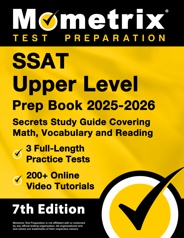The Secondary School Admission Test (SSAT) is a multiple-choice standardized exam used by many private, independent, and charter schools to screen their applicants. Students in grades 8-11 applying for high school admission will take the SSAT Upper Level test.
Click “Start Test” above to take a free SSAT Upper Level practice test, and check out our premium-quality SSAT test prep resources by clicking the links below!
SSAT Upper Level Practice Tests by Subject
If you need some extra practice in a specific subject, click one of the subjects below to get started on a subject-specific SSAT Upper Level practice test.
Test Outline
The SSAT Upper Level test contains 166 questions and one essay, and you will be given 3 hours and 10 minutes (including breaks).
The test covers four main subjects and is split into eight parts.
1. Writing Sample
In this part, you will be given 25 minutes to write a short essay based on either a personal question or a creative story starter.
This essay will not be scored, but it will be used to help evaluate your writing abilities.
2. Break (10 minutes)
3. Quantitative (Math)
In this part, you will be given 30 minutes to answer 25 math-related questions, and you will not be able to use a calculator at any time.
The questions in this part assess your knowledge of arithmetic, elementary algebra, geometry, and other concepts.
4. Reading Comprehension
In this part, which is timed at 40 minutes, you will be given multiple reading passages that are 250-350 words each. You will then be asked to answer questions about each passage. These questions assess your ability to make inferences, locate details, make predictions, determine the author’s purpose and point of view, and recognize the main idea.
5. Break (10 minutes)
6. Verbal
In this part, you will have 30 minutes to identify synonyms and interpret analogies. There are 30 synonyms to identify and 30 analogies to interpret.
These questions assess your ability to logically relate ideas to each other and your vocabulary strength.
7. Quantitative (Math)
This part is a continuation of part 3. You will have 30 minutes to answer 25 more questions related to math, and you will not have access to a calculator.
8. Experimental
In this part, you will be given 15 minutes to answer 16 experimental questions, which will not count toward your score. These are questions that are being tested to see if they are good enough to use as scored questions on future versions of the test.
The questions are split into the following subjects:
- Verbal: 6 questions
- Reading: 5 questions
- Quantitative: 5 questions
SSAT Upper Level Study Guide
Get practice questions, video tutorials, and detailed study lessons
Get Your Study Guide
Registration
To register for the test, you will need to make an account online via the SSAT website. From there, you can select which testing method works best for you and pay the applicable testing fee.
| Type of Testing | Fee |
|---|---|
| Standard or school Flex | $172 |
| SSAT at home | $258 |
| Prometric SSAT | $242 |
| Flex with educational consultant | $272 |
Test Day
There are three main testing methods to choose from:
Paper-and-pencil
This traditional version of the test is available to take in two different ways: standard and Flex.
The standard paper-and-pencil test is available on six predetermined dates and is usually taken at schools.Flex SSAT
The Flex paper-and-pencil test is available on special testing dates.
Prometric
A computer-based version of the test is available to take at Prometric testing centers across the US and Canada. Prometric testing requirements will apply, including what you are allowed to bring to the testing center.
At-home
An online version of the test is available if testing at home is best for you. It is important to note that there are many strict guidelines that apply to at-home testing, so you should ensure you can meet those guidelines before committing to this version of the test.
How the Test is Scored
On the Upper Level SSAT, you earn one point for every question you answer correctly, and only one-quarter of a point is deducted for each question you answer incorrectly. There is no penalty for skipping questions.
The total scaled score range is 1500 to 2400. On your score report, you will see your final overall score, your percentile, and your individual scores for each subject on the test.
Retaking the Test
You are welcome to take the test as many times as you wish. You will need to pay the testing fee for each retake.

Start Your SSAT Upper Level Online Prep Course
If you want to be fully prepared, Mometrix offers an online SSAT Upper Level prep course designed to give you everything you need to succeed!
Here’s what you’ll find in the SSAT Upper Level course:
- 80 Review Lessons Covering Every Topic
- 1,050 SSAT Upper Level Practice Questions
- 240+ Video Tutorials
- 450+ Digital Flashcards
- Money-back Guarantee
- Mobile Access
Everyone learns differently, so we’ve tailored the SSAT Upper Level online prep course to ensure every learner has what they need to prepare for the SSAT Upper Level exam.
Click below to check it out!
SSAT Upper Level Flashcards
Get complex subjects broken down into easily understandable concepts
Get Your Flashcards
FAQs
Q
How many questions are on the SSAT Upper Level test?
A
There are 166 questions and one essay on the test.
Q
How long is the SSAT Upper Level test?
A
The time limit for the test is 3 hours and 10 minutes, which includes all scheduled breaks.
Q
What is the passing score for the SSAT Upper Level test?
A
Any score higher than 1840 is considered to be a good score.
Q
How much does the SSAT Upper Level test cost?
A
The testing fee varies depending on your testing method of choice.


